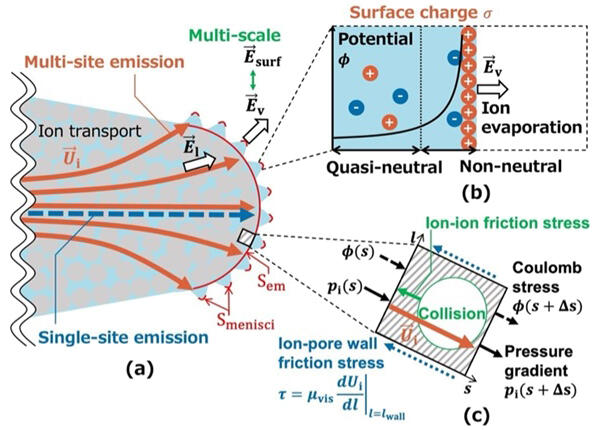Graduate Student Koki Takagi and Associate Professor Yoshinori Takao at Yokohama National University, in collaboration with Professor Kazutaka Nishiyama and Associate Professor Ryudo Tsukizaki of JAXA and Dr. Yusuke Yamashita of the University of Tokyo (now a Postdoctoral Scholar at Stanford University) researched a physical mechanism of ionic-liquid-impregnated porous emitters in vacuum releasing ions to generate thrust. The research group announced that they developed a simple theoretical model that does not require multiscale analysis of the aforementioned mechanism and succeeded in explaining the experimental results of the emitted ion current. The results are expected to be useful for predicting the performance of space propulsion vehicles using ionic liquids. The results were published in the June 22 issue of the Journal of Applied Physics, where it was selected as a featured article for the particularly noteworthy research result.

(b) Structure of the surface charge of the IL. A non-neutral region and a quasi-neutral region are formed.
(c) Stresses applied to ions in the porous emitter for momentum conservation as a continuum model.
Source: published paper. Licensed under Creative Commons Attribution-NonCommercial-NoDerivs 4.0 International (CC BY-NC-ND) license.
The development of nanosatellites has been attracting attention in space technology development. However, there are few options for low-power and efficient propulsion systems that can be installed in nanosatellites because electric propulsion systems that use plasma exhibit significant energy loss as they become smaller. Therefore, the research group aimed to significantly improve the efficiency of the systems by directly emitting ions from the ionic liquid that serves as the propellant to generate thrust, without the need for plasma.
When a high electric field is applied to the surface of a porous emitter permeated with an ionic liquid, ions can be efficiently released. This kind of porous emitter is expected to be used as a space propulsion device. However, due to the complexity of the physical phenomenon, time-consuming numerical simulations were required to predict how many ions would be released.
The study was conducted based on reports revealing that the flow of ions inside an emitter may determine ion emission. The transport of ions suppressed by the porous structure was represented by a simple model based on Ohm's law, and an equation was formulated considering the release of ions from the region above the threshold electric field.
In experiments, the shape of a porous emitter with a microscopic projection size of approximately 1 mm was precisely measured. The surface electric field was calculated numerically from its shape. The ions emitted when applying a high electric field to the surface of the emitter impregnated with an ionic liquid in a vacuum apparatus were directly measured as current values.
The relationship between the electric field and current density was formulated in a theoretical model, and the effect of different ion transport on ion emission was investigated by varying the resistance using different micro- and nanoscale porous materials. Consequently, the current values predicted by the theoretical model were in very good agreement with the experimental values, despite the simplicity of the modeling, which does not take into account complex surface conditions. Using the constructed theoretical model, it is possible to predict the emitted ions with respect to the thruster geometry at a very low cost. The model is expected to be utilized for predicting the performance of space propulsion vehicles.
Takao said, "When we started researching electrospray propulsion 10 years ago, we were the only laboratory in Japan to do so. Three years ago, however, we began joint research with the JAXA Institute of Space and Astronautical Science, and momentum is building toward practical application. This result stemmed from a proposal by a student affiliated with both the institutions. But as we continued to discuss it from its initial crude content, I think we were able to show a uniquely Japanese idea that can reproduce complex physical phenomena with a mixture of different scales using a simple model in an easy-to-understand way."
Journal Information
Publication: Journal of Applied Physics
Title: Simple model of multi-scale and multi-site emissions for porous ionic liquid electrospray thrusters
DOI: 10.1063/5.0195699
This article has been translated by JST with permission from The Science News Ltd. (https://sci-news.co.jp/). Unauthorized reproduction of the article and photographs is prohibited.




